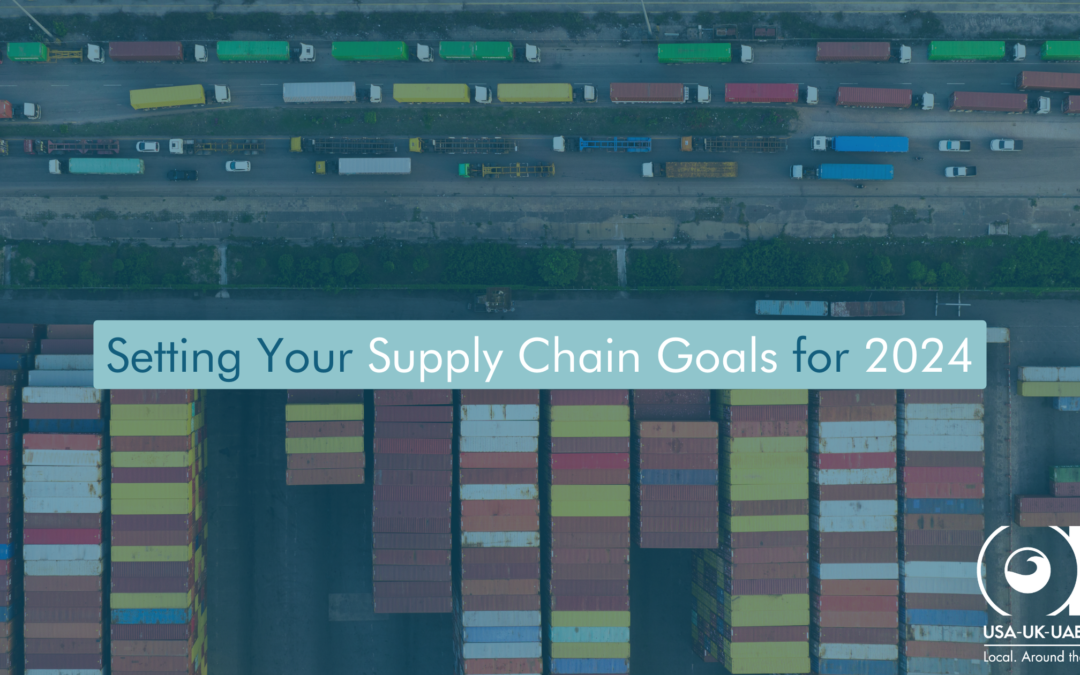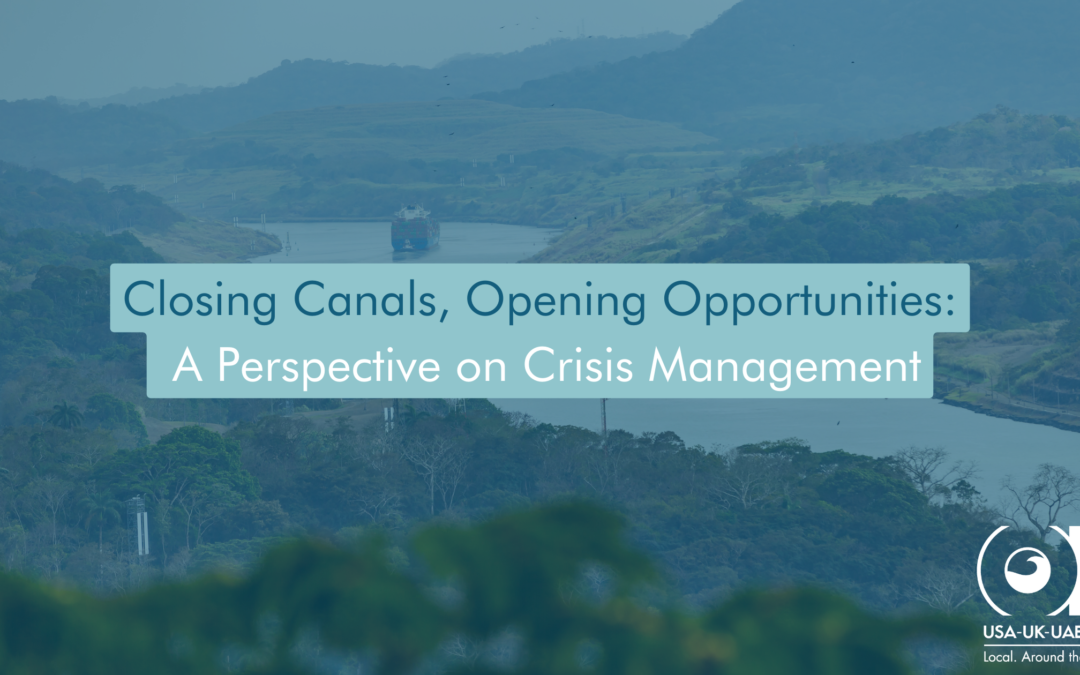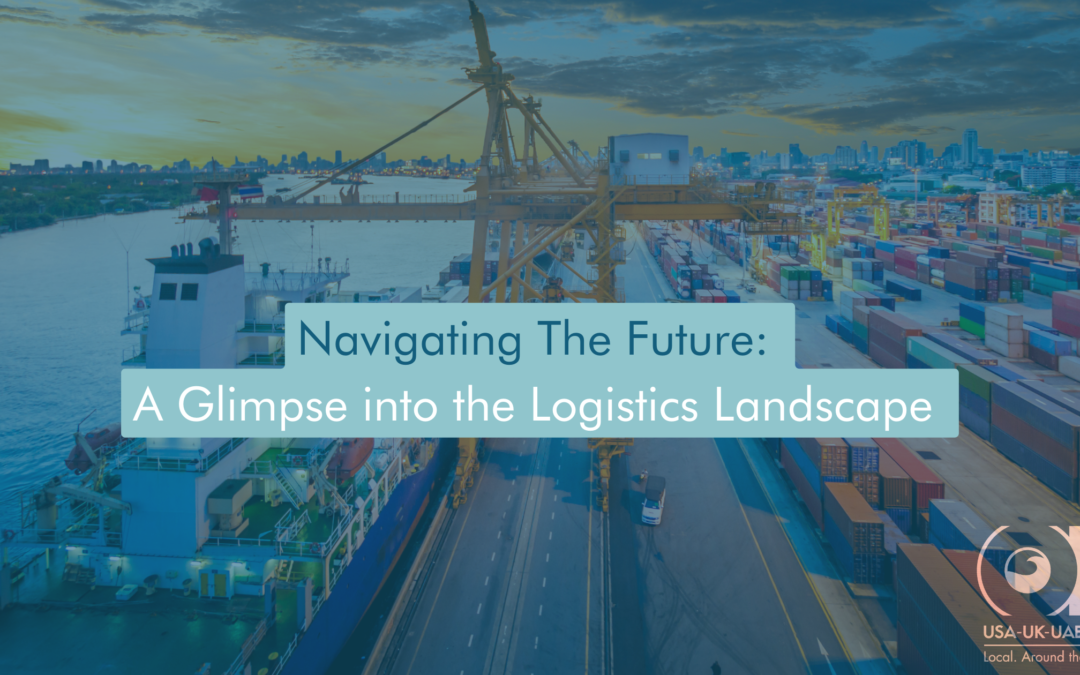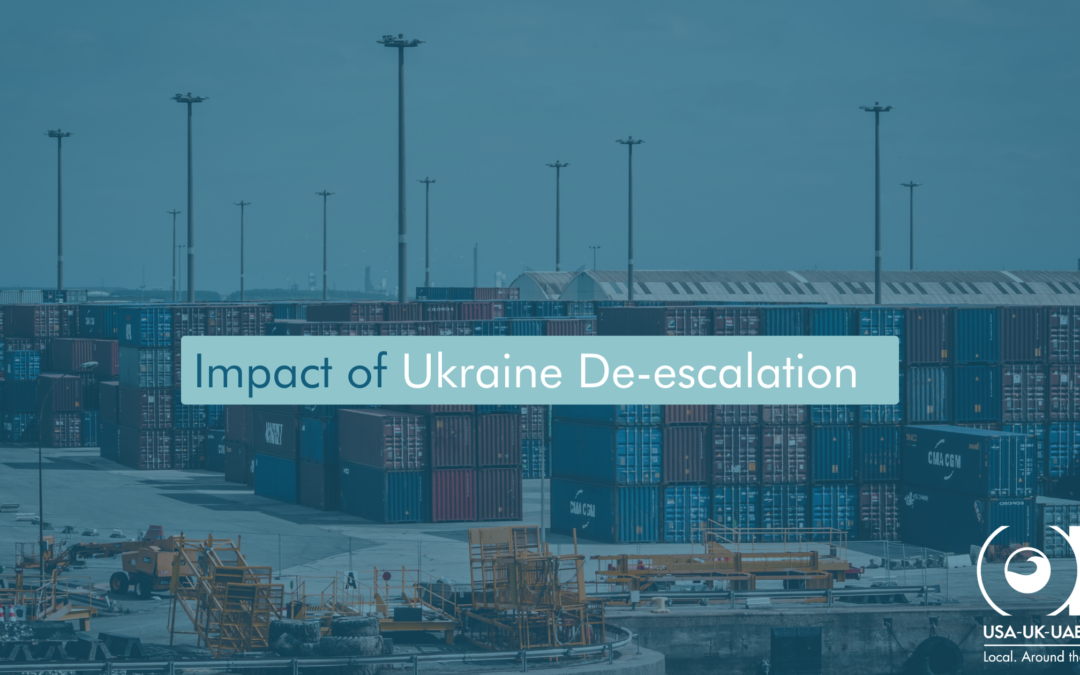
Jan 12, 2024 | Future in Logistics
Have you ever considered how the backbone of your business operations—your supply chain—could be the key to your success in 2024? As we embark on a new year, it’s crucial to reflect on the importance of effective supply chain management in this dynamic business world. This blog post is dedicated to guiding businesses in setting realistic and impactful supply chain goals for the year ahead. We’ll delve into the latest market trends, reflect on past performance, and chart a course for a successful, resilient, and innovative supply chain strategy.
Understanding the Current Supply Chain Landscape
The supply chain industry is continuously evolving, shaped by technological advancements, changing consumer behaviors, and global events. The rise of e-commerce, for instance, has revolutionized how goods are purchased and delivered, demanding more agility and efficiency from supply chains. Additionally, the adoption of AI and IoT technologies is transforming logistics operations, making them smarter and more predictive.
However, these advancements bring their own set of challenges. Businesses today face logistical hurdles, supply disruptions due to geopolitical events, and the ongoing pressure to manage costs while meeting increasing customer expectations. Understanding these trends and challenges is the first step in setting goals that are not just ambitious but also achievable.
Reflecting on Your Previous Supply Chain Performance
Before setting new goals, it’s essential to assess your previous year’s supply chain performance. Look at key metrics such as delivery times, inventory turnover rates, and customer satisfaction scores. What were the high points and low points? Perhaps your business excelled in fulfilling orders but struggled with inventory management. By identifying these areas, you can focus your efforts where they’re needed most.
Learning from past experiences, both successes and failures, is invaluable. Consider case studies from within or outside your industry for insights into effective supply chain management strategies.
Setting SMART Supply Chain Goals
SMART (Specific, Measurable, Achievable, Relevant, Time-bound) goals are vital in supply chain management. For example, rather than a vague goal like ‘improve delivery times,’ a SMART goal would be ‘reduce delivery times by 15% by the end of Q2 2024.’
When setting goals, consider areas like efficiency improvement, cost reduction, customer satisfaction enhancement, and sustainability initiatives. Each goal should align with your broader business objectives and be adaptable to changing market conditions.
Integrating Technology and Innovation
Incorporating new technologies such as AI, IoT, and blockchain can significantly transform your supply chain operations. For example, AI can optimize route planning for deliveries, while blockchain can enhance transparency and security in your supply chain. It’s not just about adopting new technologies but integrating them in ways that enhance your specific operations.
Maintaining an innovation mindset is crucial. This means being open to new ideas, continuously seeking improvements, and being willing to test and learn from new approaches. Innovations in supply chain management often lead to increased efficiency, reduced costs, and better customer experiences.
Building Resilience and Flexibility
One of the key lessons from recent years is the importance of a resilient supply chain. This involves strategies that allow your supply chain to withstand various disruptions—from natural disasters to political upheavals. This could mean diversifying suppliers, investing in predictive analytics to foresee potential disruptions, or building stronger relationships with key partners.
Flexibility is another critical aspect. The ability to quickly adapt to changing market conditions, customer demands, or supply issues is invaluable. This might involve flexible inventory management systems, agile logistics planning, or a workforce trained to handle various tasks.
Emphasizing Sustainability in Supply Chain Goals
As we move into 2024, sustainability is no longer just an optional corporate social responsibility initiative; it’s a critical component of a modern supply chain strategy. Consumers and businesses alike are increasingly aware of the environmental impact of their activities, including the supply chain processes.
Sustainability Goals:
- Eco-Friendly Practices: Set goals to reduce your carbon footprint, such as optimizing transportation routes for fuel efficiency, using eco-friendly packaging materials, or investing in renewable energy sources for your warehouses.
- Waste Reduction: Look at ways to minimize waste in your operations. This could involve more efficient inventory management to reduce overstocking, improving product design for longer lifecycles, or finding ways to repurpose or recycle materials.
- Supply Chain Transparency: Transparency is key to sustainability. Set goals around tracing the origin of your products and ensuring that all elements of your supply chain meet certain environmental and ethical standards.
Collaboration for Sustainability:
- Partner with Green Suppliers: Collaborate with suppliers who prioritize sustainability, thereby extending your environmental efforts across the supply chain.
- Educate and Involve Stakeholders: Use your influence to educate partners, employees, and customers about the importance of sustainability. Encourage them to join in your efforts for a more sustainable future.
Measuring Sustainability Impact:
- Sustainability Metrics: Just like financial or operational metrics, sustainability metrics are vital. Set specific targets for reducing emissions, waste, or energy consumption and regularly monitor your progress.
- Reporting and Compliance: Keep stakeholders informed about your sustainability efforts and achievements. Compliance with environmental regulations and standards should also be a key aspect of your sustainability goals.
By integrating sustainability into your supply chain goals, you’re not just contributing positively to the environment but also building a brand that resonates with the values of modern consumers and businesses. This approach can lead to long-term profitability and resilience, positioning your business as a forward-thinking leader in your industry.
In summary, setting strategic supply chain goals for 2024 is about understanding the current landscape, learning from the past, and proactively planning for the future. By setting SMART goals, embracing technology and innovation, and focusing on resilience and flexibility, your business can not only navigate the challenges ahead but also seize new opportunities.
As you apply these insights to your business strategy, remember that continuous improvement is key. If you need professional advice or services, don’t hesitate to seek them out. Looking forward, the future of supply chain management is bright for those who stay proactive and adaptable. Here’s to a successful, efficient, and innovative year in your supply chain endeavors!

Jan 5, 2024 | Future in Logistics
Navigating Through Canal Crises
In recent times, two of the world’s most strategic maritime passages, the Panama and Suez Canals, have encountered significant challenges that have rippled across global trade and logistics. The Panama Canal, an indispensable conduit for $270 billion in annual global trade, is grappling with a severe drought that has drastically reduced its operational capacity. This situation has not only led to a dramatic reduction in the number of vessels that can traverse the canal daily but has also spurred a crisis in water management, essential for its operation.
Simultaneously, the Suez Canal, another pivotal artery in global shipping, faced its own challenges with the infamous Ever Given blockade in March 2021, and the ongoing geopolitical tensions in the region continue to pose risks for uninterrupted access. These events underscore the fragility of our global supply chains and the outsized role these canals play in facilitating international trade.
These crises, however, also present unique opportunities, especially when navigated with the strategic insight and operational agility of Third-Party Logistics (3PL) partners. 3PLs specialize in crafting customized logistics solutions, making them invaluable in times of crisis. By leveraging their expertise, networks, and innovative approaches, 3PLs can transform these challenges into opportunities for optimization and growth.
Immediate Impacts on Shipping Times, Costs, and Logistics Strategies:
- Extended Shipping Times: The closure of both the Panama and Suez Canals would necessitate longer shipping routes. Vessels typically benefit from these canals’ shorter paths between major global markets. Without these shortcuts, ships would have to navigate around continents, like sailing around the southern tip of South America or Africa, significantly increasing transit times.
- Increased Costs: Longer routes not only mean more time but also higher costs. This includes increased fuel consumption, additional crew wages, and potential late delivery penalties. For businesses relying on just-in-time delivery, these delays could disrupt production schedules and increase inventory costs.
- Altered Logistics Strategies: Companies would need to rapidly adjust their logistics strategies. This might involve switching to different modes of transportation, like air freight for urgent deliveries, albeit at a much higher cost. There could also be a greater reliance on regional manufacturing and supply chains to mitigate these disruptions.
Potential Ripple Effects on Businesses and Economies Worldwide:
- Global Supply Chain Disruption: The closure of these canals doesn’t just affect the shipping industry; it ripples through the entire global supply chain. This could lead to shortages of goods, ranging from raw materials to finished products, potentially stalling manufacturing processes in various industries.
- Inflationary Pressures: As shipping costs rise, these increases are often passed on to consumers, contributing to inflation. Essential goods, including food and fuel, could see price hikes, impacting both individual households and the broader economy.
- Economic Slowdown: Prolonged disruptions can lead to a slowdown in economic activities. Countries heavily reliant on exports and imports through these canals may experience significant impacts on their trade balances and GDP growth.
- Shifts in Trade Routes and Alliances: Over time, businesses and nations might seek alternative trade routes and form new logistical alliances. This could reshape global trade patterns, potentially leading to a reevaluation of current trade agreements and strategies.
3PLs: Navigating Through Crisis with Expertise and Innovation
- Expertise in Complex Logistics Solutions: 3PL providers are logistics experts, adept at handling complicated supply chain challenges. In a crisis like canal closures, their deep understanding of global logistics networks becomes invaluable. They can quickly analyze the situation, identify potential impacts, and devise effective strategies to maintain the flow of goods.
- Access to a Broad Network: One of 3PLs’ most significant advantages is their extensive global network. This includes relationships with a variety of shipping companies, access to multiple transportation modes (air, sea, road, rail), and connections with local logistics providers. Such a network allows 3PLs to swiftly pivot and find alternative routes and transportation methods, minimizing disruptions.
- Technological Capabilities: Modern 3PLs leverage advanced technology for real-time tracking, route optimization, and predictive analytics. During crises, these technologies enable them to quickly assess various scenarios, reroute shipments efficiently, and provide clients with up-to-date information, ensuring transparency and trust.
- Experience in Crisis Management: 3PLs are seasoned in handling unexpected disruptions. Their experience in dealing with various logistics challenges, from natural disasters to political upheavals, positions them well to manage crises effectively.
Examples of 3PL Crisis Management:
- COVID-19 Pandemic Response: During the COVID-19 pandemic, many 3PLs demonstrated remarkable agility. They rapidly adjusted to lockdowns and border closures, rerouting shipments and utilizing different transportation modes to ensure the continuity of supply chains. Some even expedited the shift to e-commerce logistics to meet changing consumer demands.
- Natural Disaster Responses: In response to natural disasters like hurricanes or earthquakes, 3PLs have historically played a critical role in rerouting supplies, providing emergency logistics services, and even aiding in recovery efforts by ensuring the timely delivery of essential goods and materials.
- Political and Economic Turbulences: During events like the Brexit transition, 3PLs helped businesses navigate new customs regulations and border controls, minimizing trade disruptions between the UK and EU.
In essence, 3PLs are not just service providers; they are strategic partners capable of turning logistical nightmares into manageable challenges. Their expertise, network, technological prowess, and experience are pivotal in mitigating risks and ensuring the continuity of business operations during global crises like canal closures. By leveraging their capabilities, businesses can navigate these turbulent times more effectively and maintain a competitive edge in the face of adversity.
Transforming Challenges into Opportunities
In the face of unprecedented challenges like the closure of major trade arteries, there lies a hidden opportunity for businesses to innovate and strengthen their supply chains.
- Catalyst for Innovation: Times of crisis often act as a forcing function for innovation. Businesses can use these situations to rethink and revamp their supply chain strategies. This could mean adopting new technologies, exploring different transportation modes, or integrating more sustainable practices. For instance, a company might turn to AI-driven logistics platforms to enhance efficiency or explore greener shipping alternatives that also align with their CSR goals.
- Benefits of Diversification: Diversifying supply chain routes and partners is akin to not putting all your eggs in one basket. By exploring alternative shipping routes, using multiple transportation modes, and partnering with a variety of suppliers and logistics providers, businesses can reduce their dependency on any single element. This diversification not only mitigates risks but can also uncover more cost-effective and efficient logistics solutions.
- 3PLs as Strategic Partners: 3PL providers are more than just external service providers; they’re strategic partners in transforming logistical challenges into advantages. With their expertise, they can help businesses navigate through the crisis, find the best alternative routes and methods, and even identify potential improvements that can be made to the supply chain for long-term benefits.
Preparing for the Future
The closure of the Panama and Suez Canals serves as a wake-up call for businesses to proactively plan and prepare for future disruptions.
- Importance of Proactive Planning: Proactive planning is the cornerstone of a resilient supply chain. This involves regularly assessing potential risks, developing contingency plans, and staying informed about global events that could impact logistics.
- Building Resilient Supply Chains with 3PLs: 3PL providers play a crucial role in building resilience into supply chains. They offer a wealth of knowledge and resources that can help businesses prepare for various scenarios. This includes assisting in risk assessment, developing flexible logistics strategies, and providing access to a wide range of global logistics options.
- Opportunity for Reevaluation and Strengthening: This crisis presents an invaluable opportunity for businesses to reevaluate and fortify their supply chains. It’s a chance to examine current practices, identify vulnerabilities, and implement improvements. Businesses should see this as a proactive step towards not just recovery, but growth and enhanced capability in an ever-changing global market.
In summary, while the closure of key canals presents significant challenges, it also offers a unique opportunity for businesses to innovate, diversify, and strengthen their supply chains with the aid of expert 3PL partners. By embracing these challenges as catalysts for change and preparation, businesses can emerge more robust and adaptable, ready to tackle future uncertainties with confidence.

Dec 21, 2023 | Future in Logistics
In an era defined by interconnectivity and rapid globalization, the intricate dance of goods across borders has become the lifeblood of modern commerce. As businesses transcend geographical boundaries to reach consumers far and wide, the significance of efficient shipping and freight transport has never been more pronounced. In this intricate tapestry of international trade, the players who master the art of seamless logistics stand poised to thrive in the competitive landscape of 2024.
Picture this: raw materials sourced from one continent, meticulously transformed into a finished product on another, and finally finding a home on yet another continent’s retail shelves. The intricate choreography of these movements is made possible by the invisible hands of the shipping and freight transport industry. Whether it’s the timely delivery of perishable goods or the precise coordination of intricate supply chains, the efficiency of these logistical endeavors underpins the success of businesses large and small.
In the globalized marketplace, where time is of the essence and customer expectations are soaring to new heights, the ability to navigate the complexities of shipping and freight transport is not just a competitive advantage—it’s a necessity. As we stand on the precipice of 2024, the spotlight on the logistics industry intensifies, and businesses are turning to trusted partners, particularly Third-Party Logistics (3PL) providers, to navigate the challenges and seize the opportunities that lie ahead.
Technology Integration: Paving the Way for Tomorrow’s Logistics
In the ever-evolving landscape of logistics, technology emerges as the beacon guiding the industry toward unprecedented efficiency and innovation. As we stand at the cusp of 2024, the role of technology in reshaping logistics has transcended the conventional, becoming a transformative force that navigates the sector into uncharted territories of possibility.
Unveiling the Tech Tapestry: The logistics of yesteryears are giving way to a new era, where the seamless integration of technology is not merely a choice but an imperative. From the humble warehouse to the global supply chain network, the impact of technological advancements is palpable. Imagine a network where every item in transit is not just a mere package but a data source, providing real-time insights into its journey—this is the power of the Internet of Things (IoT).
IoT: A Symphony of Connectivity: IoT, with its interconnected web of smart devices, is revolutionizing how we perceive and manage logistics. Sensors on shipments track temperature, humidity, and location, ensuring that delicate cargo arrives unscathed. This level of visibility not only mitigates risks but empowers businesses with data-driven decision-making capabilities. In a world where time is currency, real-time tracking transforms uncertainty into assurance.
AI: The Intelligent Navigator: Enter the realm of Artificial Intelligence (AI), where algorithms and machine learning algorithms are not just buzzwords but the architects of efficiency. AI, with its ability to analyze vast datasets, predicts trends, optimizes routes, and enhances demand forecasting. The once unpredictable nature of logistics now bows to the prowess of intelligent systems, reducing costs, and bolstering operational excellence.
Blockchain: Fortifying Security and Transparency: In the age of information, trust is paramount. Blockchain, a decentralized ledger, is the guardian of security and transparency in the supply chain. Every transaction, from the origin of raw materials to the final destination, is etched into an incorruptible digital ledger. This not only minimizes the risk of fraud but ensures an unbroken chain of custody, fostering a new level of trust among stakeholders.
As we navigate the labyrinth of logistical challenges, technology stands as the guiding light, illuminating the path toward enhanced visibility, efficiency, and security. The integration of IoT, AI, and blockchain isn’t just a technological upgrade; it’s a paradigm shift that empowers businesses to not only meet but exceed the expectations of a fast-paced, interconnected world. Join us as we delve deeper into this brave new world where logistics and technology converge to redefine the very fabric of global supply chains.
Customer-Centric Logistics: Elevating the Journey of Goods
In the intricate dance of global commerce, where products traverse continents and logistics networks span the globe, a new maestro has emerged—the customer. As we stride confidently into 2024, the spotlight on customer-centric logistics is not just a trend but a paradigm shift, recognizing the end consumer as the true north of the supply chain compass.
The Evolution of Expectations: Gone are the days when logistics was merely a behind-the-scenes player, orchestrating the movement of goods with an invisible hand. Today, the customer’s experience is not confined to the moment of purchase but extends seamlessly into the entire journey of their awaited package. The expectations have shifted, and businesses are acknowledging the need to align their logistical prowess with the desires and demands of the end consumer.
Real-Time Visibility: At the heart of customer-centric logistics lies the commitment to transparency. Imagine a world where customers don’t just wait for a vague delivery window but are empowered with real-time visibility into the whereabouts of their package. This is the reality that technology, coupled with logistical finesse, can deliver. By providing customers with live tracking, timely updates, and clear communication, businesses are not just delivering goods—they’re delivering peace of mind.
Personalization as the Cornerstone: In the age of customization, generic one-size-fits-all logistics solutions fall short. Recognizing this, customer-centric logistics is all about tailoring the experience to individual preferences. From flexible delivery options to personalized packaging, businesses are weaving a bespoke tapestry that not only meets but exceeds customer expectations. After all, it’s not just about delivering a product; it’s about delivering an experience that resonates.
Responsive Customer Service: In the intricate ballet of logistics, hiccups are inevitable. However, what sets businesses apart is their ability to respond swiftly and effectively. Customer-centric logistics acknowledges that problems may arise, but it transforms these challenges into opportunities to showcase impeccable customer service. Responsive communication, proactive issue resolution, and a genuine commitment to customer satisfaction become the hallmarks of businesses that prioritize the customer journey.
In the dynamic world of 2024, the global shipping and freight transport industry stands at a pivotal crossroads, marked by the integration of cutting-edge technology and a steadfast commitment to customer-centric logistics. This year heralds a transformative era where Internet of Things (IoT), Artificial Intelligence (AI), and Blockchain technologies revolutionize logistical operations, enhancing efficiency, transparency, and security. Simultaneously, an ever-increasing focus on personalized customer experiences redefines the industry, emphasizing real-time visibility, tailored solutions, and responsive service. As these trends converge, Third-Party Logistics (3PL) providers emerge as key facilitators, adeptly navigating this complex landscape, ensuring that businesses not only meet but exceed the evolving expectations of a highly interconnected and competitive global marketplace.

Dec 15, 2023 | Future in Logistics
What’s the impact on global shipping if the Red Sea tensions continue to rise?
In the intricate tapestry of global shipping, the Red Sea stands as a linchpin, weaving together the diverse threads of international trade and commerce. Nestled between the continents of Africa and Asia, this maritime passage has long served as a vital conduit for the seamless flow of goods, connecting major shipping routes and facilitating the exchange of commodities on a grand scale.
Picture the Red Sea as a bustling maritime highway, teeming with vessels bearing the lifeblood of global supply chains. Its strategic location has made it a preferred route for countless ships, serving as a gateway between the Mediterranean and the Indian Ocean. The Suez Canal, a testament to engineering prowess, further enhances the Red Sea’s significance, providing a shortcut that shaves precious time and costs off maritime journeys.
The Red Sea, with its strategic ports and proximity to key markets, has become a linchpin for our operations, allowing us to optimize routes, minimize transit times, and ensure the timely delivery of goods for our clients. The reliability of this shipping lane is integral to the seamless execution of supply chain strategies, enabling businesses to meet customer demands with precision.
Geopolitical Factors
A. Examination of Geopolitical Tensions in the Red Sea Region
In the intricate world of global logistics, geopolitical factors loom large over the safety and security of vital shipping lanes, and the Red Sea is no exception. This section delves into the complex tapestry of geopolitical tensions and conflicts that can cast a shadow over maritime activities in this crucial region. As tensions ebb and flow, the stability of shipping routes becomes a barometer for the broader geopolitical landscape.
B. The Impact of Political Instability on Shipping Safety
Political instability can send reverberations throughout the maritime domain, creating an environment where the safety of civilian vessels hangs in the balance. This subsection explores how political unrest, regional conflicts, and diplomatic uncertainties can lead to an increased risk for shipping activities. Understanding these dynamics is crucial for businesses seeking to navigate the unpredictable waters of international trade.
C. Examples of Past Events Impacting Maritime Security
History serves as a powerful teacher, and in this section, we reflect on past events that have shaped the maritime security landscape in the Red Sea region. From historical conflicts to piracy concerns, we examine instances where geopolitical factors have directly impacted shipping safety. These examples provide valuable insights into the potential challenges that may arise and underscore the need for a proactive and informed approach to logistics.
Economic Implications
A. Analysis of Economic Consequences from Disrupted Global Shipping Routes
The economic ramifications of disrupted shipping routes extend far beyond the immediate concerns of the shipping industry. In this segment, we conduct a comprehensive analysis of the domino effect that disruptions in the Red Sea can trigger. From supply chain interruptions to market fluctuations, we explore how economic ripples can extend across industries and borders.
B. Increased Shipping Costs and Potential Delays
With disrupted shipping routes come practical challenges that directly impact the cost-effectiveness of logistics operations. This subsection scrutinizes the potential escalation in shipping costs and the ripple effects of potential delays. Businesses reliant on timely and cost-efficient transportation face the prospect of operational challenges, requiring a strategic reassessment of budgetary considerations.
C. Impact on International Trade and Business Operations
International trade thrives on the predictability and efficiency of shipping routes. Here, we examine how disruptions in the Red Sea can reverberate across international trade networks, affecting the seamless flow of goods between nations. The interconnectedness of global business operations means that challenges in one region can have widespread consequences, necessitating a holistic approach to risk management and supply chain resilience.
In navigating the geopolitical intricacies and economic implications outlined in this analysis, businesses can arm themselves with knowledge and strategic foresight. As your trusted logistics partner, we remain committed to providing proactive solutions that safeguard your supply chain against potential disruptions, ensuring the continued success of your global operations.

Dec 8, 2023 | Future in Logistics
Global Logistics: Navigating Opportunities After Conflict Resolution
In the complex arena of international geopolitics, the ongoing conflict in Ukraine stands as a focal point with far-reaching implications. As discussions around potential resolutions gain momentum, there arises a need to objectively examine the potential impacts on various facets of global affairs. One such crucial aspect is the intricate web of trade agreements that binds nations together economically. In this exploration, we aim to neutrally analyze how the resolution of the Ukraine conflict could introduce shifts in existing trade agreements, potentially leading to the easing of trade restrictions and the exploration of new markets.
Potential Impact on Trade Agreements:
Examining Diplomatic Shifts: The resolution of the Ukraine conflict holds the potential to reshape the geopolitical landscape, triggering diplomatic shifts among nations. As international tensions ease, the atmosphere for negotiation and collaboration improves. This, in turn, can have a cascading effect on existing trade agreements. Countries previously restrained by political considerations may find common ground for more amicable economic cooperation. The diplomatic corridors, once clouded by uncertainty, may open up avenues for dialogue and renegotiation.
Easing Trade Restrictions: A key consequence of diplomatic resolutions could be the easing of trade restrictions that have been imposed due to geopolitical tensions. Tariffs, embargoes, and other barriers that hinder the free flow of goods may see a gradual relaxation. This easing of restrictions can unlock previously constrained trade routes, allowing for a more fluid movement of goods across borders. It not only simplifies logistical operations but also holds the potential to reduce costs, making international trade more accessible and economically viable for businesses.
Opening Up New Markets: The resolution of the Ukraine conflict may act as a catalyst for the opening up of new markets. Countries involved in diplomatic resolutions may seek to diversify their trade partnerships and explore fresh economic avenues. For 3PL providers, this implies a broader canvas on which to operate. New markets represent untapped potential for logistics services, offering opportunities for expansion and growth. The diversification of trade alliances could lead to the emergence of novel supply chain routes, prompting 3PL providers to adapt their strategies to accommodate these evolving dynamics.
Enhancing Global Collaboration: Beyond the direct impact on individual trade agreements, the resolution of the Ukraine conflict has the potential to foster a spirit of collaboration on a global scale. Nations, recognizing the interdependence of their economies, may engage in collaborative efforts to strengthen international trade norms. This collaborative approach could manifest in the development of more standardized trade practices and regulations, providing a more predictable and stable environment for 3PL providers to operate within.
Collaborations Among Nations:
Fostering Diplomatic Resolutions: Diplomatic resolutions have the potential to serve as catalysts for enhanced collaboration among nations. As tensions de-escalate, diplomatic channels open up, providing an avenue for dialogue and mutual understanding. This newfound spirit of cooperation may extend beyond immediate conflict resolution, fostering broader diplomatic ties. Closer collaborations among nations become plausible, driven by shared economic interests and the recognition of the interconnected nature of the global economy. In this context, the prospect of strengthened diplomatic relations holds the promise of creating a more stable and conducive environment for international trade.
The Role of 3PL Providers in Facilitating Trade Relationships: Within the realm of evolving diplomatic collaborations, 3PL providers emerge as pivotal facilitators of smoother trade relationships. As nations seek to strengthen their economic ties, efficient logistics and supply chain management become imperative. 3PL providers, equipped with expertise in navigating complex international trade networks, play a crucial role in ensuring the seamless flow of goods. Their ability to offer tailored logistics solutions aligns with the diverse needs of collaborating nations, promoting efficiency, reliability, and cost-effectiveness in the movement of goods across borders.
Enhancing International Supply Chain Networks: The collaborative efforts spurred by diplomatic resolutions extend to the enhancement of international supply chain networks. 3PL providers, with their intricate understanding of supply chain dynamics, contribute to the optimization of these networks. By leveraging their global infrastructure and expertise, 3PL providers assist nations in developing resilient and agile supply chains. This collaborative approach aims to enhance the overall efficiency of international trade, minimizing bottlenecks and disruptions. As nations forge closer ties, 3PL providers play a proactive role in aligning supply chain strategies with the evolving landscape of diplomatic collaborations.
Promoting Economic Interdependence: Closer collaborations among nations foster economic interdependence, where each country’s prosperity becomes intertwined with the success of its trading partners. In this context, 3PL providers act as enablers, ensuring that the benefits of economic interdependence are realized through streamlined logistics and supply chain operations. The resulting synergy contributes to the creation of a more robust and interconnected global trade ecosystem.
In essence, as diplomatic resolutions pave the way for closer collaborations among nations, 3PL providers assume a central role in facilitating smoother trade relationships and enhancing international supply chain networks. Their expertise becomes instrumental in navigating the complexities of evolving diplomatic ties, ultimately contributing to the resilience and efficiency of the global trade landscape.







